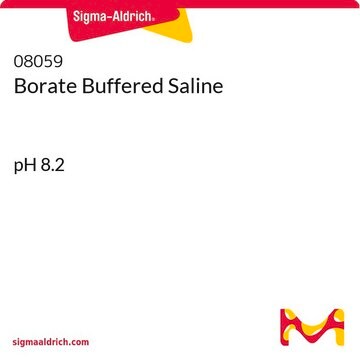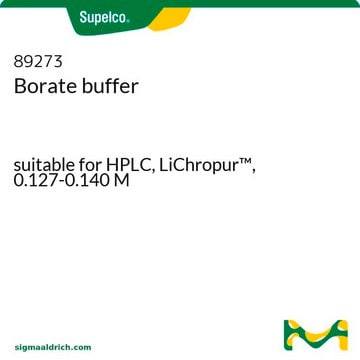B2645
Ácido bórico
tablet, 1 g boric acid per tablet
About This Item
Produtos recomendados
pressão de vapor
2.6 mmHg ( 20 °C)
Nível de qualidade
Ensaio
≥95% (titration)
Formulário
tablet
pH
5.1 (25 °C, 1.8 g/L)
pf
160 °C (dec.) (lit.)
solubilidade
water: 1 tablet/100mL, clear, colorless
temperatura de armazenamento
room temp
cadeia de caracteres SMILES
OB(O)O
InChI
1S/BH3O3/c2-1(3)4/h2-4H
chave InChI
KGBXLFKZBHKPEV-UHFFFAOYSA-N
Procurando produtos similares? Visita Guia de comparação de produtos
Aplicação
- Effect of Boron Content in LiOH Solutions on the Corrosion Behavior of Zr-Sn-Nb Alloy.: This study investigates how varying boron content in lithium hydroxide solutions affects the corrosion behavior of Zr-Sn-Nb alloys, highlighting the potential implications for materials used in nuclear reactors (Zhao et al., 2024).
- Evaluation of living bacterial therapy assisted by pH/reactive oxygen species dual-responsive sodium alginate-based hydrogel for wound infections.: This research evaluates a boric acid-containing hydrogel for its effectiveness in treating wound infections through pH and reactive oxygen species responsiveness, indicating innovative applications in wound care (Miao et al., 2024).
Reconstituição
Palavra indicadora
Danger
Frases de perigo
Declarações de precaução
Classificações de perigo
Repr. 1B
Código de classe de armazenamento
6.1C - Combustible acute toxic Cat.3 / toxic compounds or compounds which causing chronic effects
Classe de risco de água (WGK)
WGK 1
Ponto de fulgor (°F)
Not applicable
Ponto de fulgor (°C)
Not applicable
Equipamento de proteção individual
Eyeshields, Gloves, type P3 (EN 143) respirator cartridges
Escolha uma das versões mais recentes:
Já possui este produto?
Encontre a documentação dos produtos que você adquiriu recentemente na biblioteca de documentos.
Os clientes também visualizaram
Active Filters
Nossa equipe de cientistas tem experiência em todas as áreas de pesquisa, incluindo Life Sciences, ciência de materiais, síntese química, cromatografia, química analítica e muitas outras.
Entre em contato com a assistência técnica







